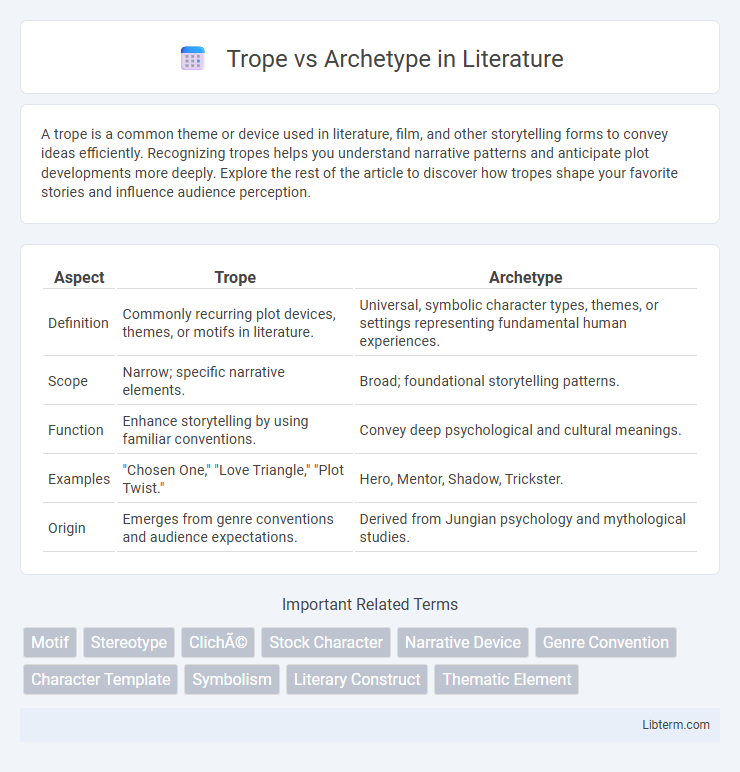A trope is a common theme or device used in literature, film, and other storytelling forms to convey ideas efficiently. Recognizing tropes helps you understand narrative patterns and anticipate plot developments more deeply. Explore the rest of the article to discover how tropes shape your favorite stories and influence audience perception.
Table of Comparison
| Aspect | Trope | Archetype |
|---|---|---|
| Definition | Commonly recurring plot devices, themes, or motifs in literature. | Universal, symbolic character types, themes, or settings representing fundamental human experiences. |
| Scope | Narrow; specific narrative elements. | Broad; foundational storytelling patterns. |
| Function | Enhance storytelling by using familiar conventions. | Convey deep psychological and cultural meanings. |
| Examples | "Chosen One," "Love Triangle," "Plot Twist." | Hero, Mentor, Shadow, Trickster. |
| Origin | Emerges from genre conventions and audience expectations. | Derived from Jungian psychology and mythological studies. |
Understanding Tropes and Archetypes
Tropes are recurring narrative devices or themes commonly recognized in storytelling across genres, acting as familiar elements that audiences can quickly identify. Archetypes represent universal, symbolic characters or motifs rooted in collective unconscious, embodying fundamental human experiences and emotions. Understanding tropes and archetypes enables deeper analysis of storytelling techniques and character development in literature and media.
Defining Tropes: Common Patterns in Storytelling
Tropes are recurring motifs or narrative devices that appear frequently across various stories, serving as familiar shortcuts for audience recognition. These common patterns in storytelling include character types, plot elements, or thematic symbols that help convey ideas quickly and effectively. Unlike archetypes, which are universal and timeless models of characters and plots, tropes are more specific to genre conventions and cultural trends.
What is an Archetype? Origins and Examples
An archetype is a universally recognizable character, symbol, or theme that recurs across literature, mythology, and art, rooted in the collective unconscious as theorized by Carl Jung. Origins of archetypes stem from ancient narratives and cultural myths, embodying fundamental human experiences such as the Hero, the Mentor, and the Shadow. Examples include the Hero's Journey seen in characters like Odysseus and Luke Skywalker, the Wise Old Man represented by Merlin, and the Trickster found in figures like Loki and Anansi.
Key Differences Between Tropes and Archetypes
Tropes are recurring themes or motifs used in storytelling that often rely on cliches or familiar patterns, while archetypes represent universal, timeless characters or symbols rooted in collective human experience. Key differences include their scope and usage: archetypes embody fundamental human roles and psychological patterns, such as the Hero or the Mentor, providing deeper narrative significance, whereas tropes function as recognizable narrative shortcuts or devices like the "damsel in distress" or "the chosen one." Tropes tend to be more flexible and context-dependent, but archetypes maintain consistent symbolic meaning across cultures and eras.
The Role of Tropes in Modern Media
Tropes serve as recognizable storytelling devices in modern media, shaping audience expectations and enhancing narrative engagement through familiar patterns. Unlike archetypes, which are universal character models rooted in psychology, tropes are more fluid and context-dependent, evolving with cultural trends and genre conventions. Their strategic use in films, television, and digital content helps creators quickly convey complex ideas and evoke emotional responses by tapping into shared cultural references.
Archetypes Across Cultures and Myths
Archetypes across cultures and myths represent universal symbols and characters that resonate deeply within the human psyche, such as the Hero, the Mentor, and the Shadow. These archetypes, identified by psychologist Carl Jung, serve as foundational templates that shape stories and folklore worldwide, reflecting shared human experiences and values. Their recurrence in diverse mythologies highlights common themes of transformation, struggle, and morality essential to cultural identity and storytelling.
Tropes: Creative Tool or Cliché Trap?
Tropes serve as familiar storytelling devices that can efficiently convey complex ideas and emotions when used creatively, enhancing narrative structure and audience engagement. However, overreliance on tropes often leads to predictability and reinforces cliches, diminishing originality and depth in characters and plots. Effective use of tropes requires balancing innovation and recognition, transforming potential cliches into fresh, meaningful expressions within various genres.
How Archetypes Shape Character Development
Archetypes serve as foundational models in character development, providing universal patterns that resonate deeply with audiences across cultures. These timeless symbols guide writers in crafting multidimensional characters by embodying core human experiences, such as the Hero, the Mentor, or the Outlaw. By leveraging archetypes, authors create characters with predictable behavioral traits and emotional journeys, enabling richer narrative depth and meaningful character growth.
Interplay Between Tropes and Archetypes in Narrative
Tropes and archetypes function as fundamental building blocks in storytelling, with archetypes representing universal character and plot models while tropes serve as recurring motifs or storytelling devices. The interplay between tropes and archetypes enriches narrative complexity by allowing familiar archetypal patterns to be expressed through varied and dynamic tropes. This synergy deepens thematic resonance and audience engagement, as tropes provide fresh context and nuance to the enduring structure offered by archetypes.
Evolving Tropes and Archetypes in Contemporary Storytelling
Evolving tropes and archetypes in contemporary storytelling reflect shifts in cultural values and audience expectations, often subverting traditional narrative patterns to create more complex and relatable characters. Contemporary writers adapt classic archetypes, such as the hero or mentor, by infusing them with diverse backgrounds and psychological depth, enhancing emotional resonance and relevance. Tropes, once predictable cliches, are reinterpreted through innovative frameworks, driving fresh thematic exploration and expanding the scope of genre storytelling.
Trope Infographic

 libterm.com
libterm.com